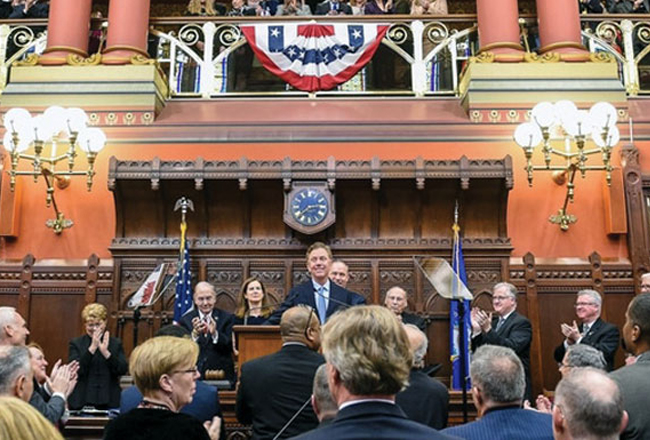How the business of education is conducted in Connecticut could soon be significantly different, if initiatives backed by Gov. Ned Lamont come to pass.
One of those initiatives is centered on shifting 25 percent of the cost of teacher pensions to Connecticut municipalities ”” which currently pay nothing to defray those spiraling costs. Under the governor”™s budget proposal, municipalities would contribute $49.2 million toward teacher pension costs in Fiscal Year 2021 and $71.5 million in FY 2022, but the contribution requirement would not be distributed equally.

The issue of the teachers”™ pension fund has haunted the state for a number of years ”” and it is not going away. The state”™s annual payment to the fund is about $1.3 billion this fiscal year, and has been projected to grow to as much as $6.2 billion by the Center for Retirement Research at Boston College.
Under Lamont”™s formula, the state”™s most fiscally and economically distressed municipalities would only have to take on 5 percent. The Department of Economic and Community Development identifies 25 municipalities as “distressed,” with Bridgeport the only one in Fairfield County.
30 PERCENT MORE
Lamont said during his Feb. 20 budget address to the General Assembly, “Many of our school districts have chosen to pay their teachers much more than the state median. It”™s a great investment for their community. But it”™s an investment that impacts the state”™s overall pension cost.
“Our budget will ask every municipality to make a contribution toward normal teacher costs, but towns like Greenwich, which pay teachers 30 percent more than the average salary, will pay more toward their pensions,” he continued.
According to the governor”™s office, the median teacher salary in the state is about $78,000. In addition to Greenwich, Fairfield County municipalities paying more than that include Danbury, Darien, Easton, Fairfield, Monroe, New Canaan, Newtown, Norwalk, Redding, Shelton, Stamford, Stratford, Trumbull, Weston, Westport and Wilton.
“This reform ensures that municipalities have some skin in the game and the pension burden is shared more fairly,” Lamont declared.
The “fairness” is being questioned by some. While Westport would see an increase in its Education Cost Sharing (ECS) aid of $18,861 in FY20 and $37,362 in FY21, it would be required to pay a respective $607,762 and $1.2 million toward teacher pensions during the same time.
Ridgefield, which stands to see cuts in its ECS of $1,528 in FY20 and $2,663 in FY21, would have to pay a respective $458,602 and $947,057 toward the pension fund.
Ridgefield First Selectman Rudy Marconi said he viewed the arrangement as unfair. “You”™re adding another surcharge on top of what we”™re paying already and we”™re already paying more than our share,” he said.
Marconi allowed that, “We knew something like this was coming and this will have less impact than what (former Gov. Dannel) Malloy was proposing,” a $400 million bill for municipalities.
Marconi, who is also president of the Connecticut Council of Small Towns (COST) and vice chairman of the Western Connecticut Council of Governments (WestCOG), added that, “We believe the governor was listening when we said that we would have to walk in (such payments) over a number of years. And we would very much like to see an opportunity for municipal leaders to have a seat at the table” when it comes to such policy decisions.
Other municipal leaders also expressed anxiety over the pension proposal. Jayme Stevenson, Darien first selectman and WestCOG chairman, said she was concerned about the proposal”™s possible impact on property taxes, while Newtown First Selectman Dan Rosenthal wondered if such an approach could snowball in the future.
“The problem is that Newtown will be contributing into a system it has no control over and what may be a 25 percent share of ”˜normal cost”™ today could very easily become a much larger share tomorrow,” he said.
“What guarantees will the town receive as to the management of the pension assets, and will the state continue to fund its share? This kind of a structural shift has implications that will extend far beyond the best intentions of present leadership. I am afraid this represents a slippery slope for Newtown taxpayers.”
Monroe First Selectman Ken Kellogg ”” who unlike Lamont and the aforementioned municipal leaders is a Republican ”” also expressed alarm. “While the potential impact is not nearly as dramatic as was proposed two years ago by former Gov. Malloy, the estimated cost to Monroe is just over $1 million in next year”™s budget and over $2.1 million in fiscal year 2020-2021,” he said. “While the state budget is far from complete, we must plan accordingly.”
CONSOLIDATION ON THE WAY?
Lamont”™s other major initiative affecting education involves consolidating some smaller school districts in an effort to save costs ”” an idea that Lamont brought up last year when campaigning. “We have 169 municipalities that cannot afford to continue to subsidize inefficiencies,” he told the Business Journal last September. “Sharing services is something I”™d explore. Why do we need 169 tax collectors, or over 100 superintendents and deputy superintendents? We have more administrators outside of the classroom than we do teachers inside.”
A public hearing on three bills related to mandatory school regionalization will be held March 1 in the Legislative Office Building in Hartford. SB 738, introduced by State Senate President Pro Tempore Martin Looney, would consolidate school districts in towns with populations of fewer than 40,000. SB 457, sponsored by Senate Majority Leader Bob Duff (Norwalk and Darien), would require any school district with a student population of fewer than 2,000 students to join a new or an existing regional school district.
The third, SB 874, has been proposed by Lamont. It seeks the appointment of a Commission of Shared School Services, which would develop a plan for the redistricting or consolidation of school services and school districts by December 2020.
Among the opponents of consolidation, or regionalization, are House Minority Leader Themis Klarides and Senate Minority Leader Len Fasano, who have said they prefer the state work through any such plan with the municipalities themselves, rather than simply decree how consolidations would take place.
Connecticut System of Colleges and Universities President Mark Ojakian ”” who has been trying to get his own consolidation in place to save costs at the higher-education level ”” said that while he was pleased with Lamont”™s “thoughtful budget,” he remained hopeful that more state money could be found for the CSCU.
“If the state college and university system ends up with level funding plus support for fringe benefit increases, significant financial problems will remain ”” totaling a $57 million shortfall between the community colleges and state universities ”” and would necessitate tuition increases, drawdowns of dwindling reserves or likely both,” he said.
According to Ojakian, estimates show that with a 0 percent state appropriation increase and no changes to tuition and fees, the community colleges will face a $25.3 million shortfall. If tuition is raised by 2.5 percent, as it has been for the past two years, the shortfall would be $21.3 million. Projected reserves for the community colleges are $39.1 million.
For the state universities, the projected shortfall is $31.7 million with a zero percent state appropriation increase and no changes to tuition and fees. If tuition is raised by 4 percent, as it has been for the past two years, the shortfall would be $21.1 million. Projected reserves for the state universities are $144.3 million.





















This is a really well written article. I do not know the journalist, nor have I ever heard about him prior to reading this. I am busy but it was so well written that I am taking the time to express my appreciation of the writing style. As I was reading this I appreciated how it was organized to make it easy to understand all the issues at play, and that even so small an article can be enjoyable to read, despite the topic, if it is written with journalistic mastery.